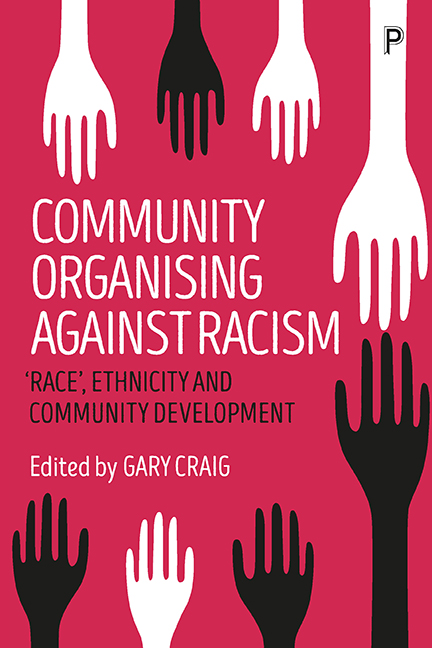Book contents
- Frontmatter
- Dedication
- Contents
- List of figures
- Author biographies
- List of abbreviations
- Introduction
- Section One Community development with ethnic minorities: history, theory, policy
- Section Two Building capacity with BME groups
- Section Three Working with Roma communities
- Section Four Global experience
- Section Five Working across cultural boundaries: ideological and personal reflections
- Afterword: Messages for community development in working with minority groups
- Index
Fifteen - The balancing act: community agency leadership in multi-ethnic/multiracial communities
Published online by Cambridge University Press: 12 April 2022
- Frontmatter
- Dedication
- Contents
- List of figures
- Author biographies
- List of abbreviations
- Introduction
- Section One Community development with ethnic minorities: history, theory, policy
- Section Two Building capacity with BME groups
- Section Three Working with Roma communities
- Section Four Global experience
- Section Five Working across cultural boundaries: ideological and personal reflections
- Afterword: Messages for community development in working with minority groups
- Index
Summary
Toronto has become one of the most diverse cities in North America, and certainly the most diverse in Canada. In 2004 Toronto had the second-largest number of foreign-born residents of any major world city (UNDP, 2004). By 2011, nearly 50% of the total population were ethnic/visible minorities, with the top five visible minorities quickly becoming the ‘visible majority’; these included South Asians, making up 12.3% of the population; Chinese, 10.8%; Black, 8.5%; Filipino, 5.1%; and Arab/West Asian/Afghan (that is, Assyrian and Iranian), 3.1% (Statistics Canada, 2011). In such an ethnically diverse environment, challenges are inevitable. Since ethnicity is a contested term with varying ontological and epistemological challenges I will borrow Varshney's definition to nail down how I intend to relate to the term. By ethnicity I mean a ‘term which designates a sense of collective belonging, which could be based on common descent, language, history, culture, race, or religion (or combination of these)’ (Varshney, 2007, p 277).
The communities on which this chapter focuses are nestled within two of the most diverse federal political boundaries in Canada – York West and York South Weston – in Northwest Toronto. In York West, over 72% of the population is non-white, while in York South Weston over 50% of the population is non-white. In York West, the top three ethnic groups proportionately are White (27.5%), Black (22.4%),and South Asian (16.0%). In York South Weston the top three groups are White (44.9%), Black (21.1%) and Latin American (9.0%) (City of Toronto, 2011). Within each of these political boundaries are three communities, whose real names have been altered, which we will call Days, Chalks and Falls. Days is ethnically dominated by South Asians; Falls comprises predominantly Somalis and Black/Afrodisaporic Caribbean peoples; and Chalks comprises predominantly Spanishspeaking peoples. This categorisation of course begs the question as to whether or not Somalis are Black and requires deeper analysis than I can provide here. This classification is based solely on self-segregation of peoples in the communities. Although the primary focus of the chapter will be on my work with these communities, I will draw on community work in other communities in Toronto, as I have similar experiences throughout.
These communities are part of, or very close to, communities identified by the city of Toronto as Neighbourhood Improvement Areas (NIA), classified as such because of the lack of resources and levels of poverty.
- Type
- Chapter
- Information
- Community Organising against Racism'Race', Ethnicity and Community Development, pp. 245 - 256Publisher: Bristol University PressPrint publication year: 2017

